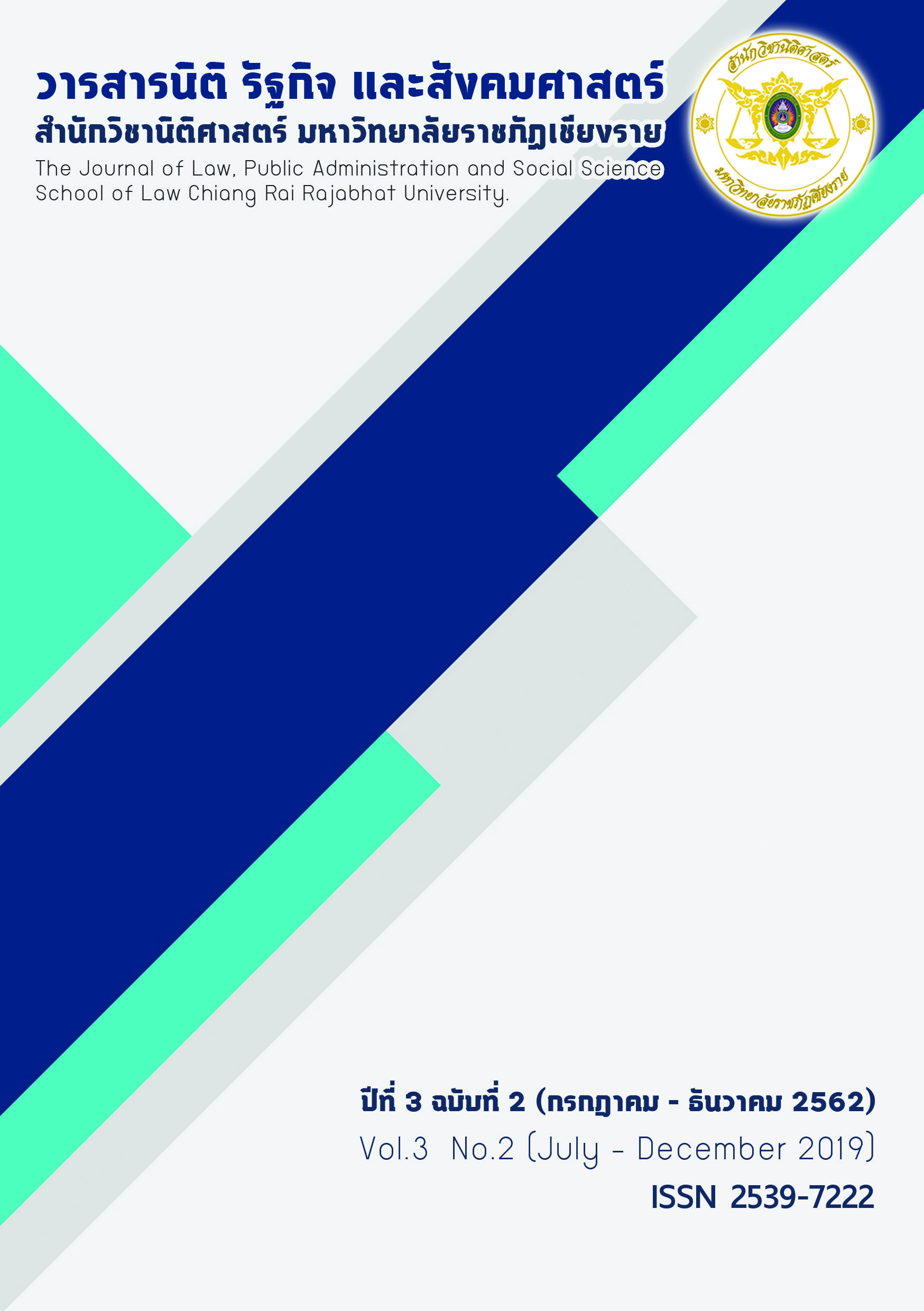การคุ้มครองสิทธิทางกฎหมายและการป้องกันการกระทำความผิดทางอาญาของเด็กและเยาวชนในพื้นที่อำเภอเมือง จังหวัดพะเยา
Main Article Content
บทคัดย่อ
การคุ้มครองสิทธิของเด็กและเยาวชนในกระบวนการยุติธรรมที่มีประสิทธิภาพจำเป็นต้องมี “มาตรการทางกฎหมายเพื่อคุ้มครองเด็กและเยาวชนในกระบวนการยุติธรรม” ที่สามารถคุ้มครองสิทธิเด็กและเยาวชนในกระบวนการยุติธรรมและป้องกันมิให้เด็กและเยาวชนเข้าสู่กระบวนการยุติธรรมทางอาญา ด้วยการควบคุมพฤติกรรมเสี่ยงต่อการกระทำความผิด โดยมาตรการดังกล่าวต้องให้การดูแลและบำบัดฟื้นฟูเพื่อแก้ไขพฤติกรรมตามแต่ความจำเป็นของเด็กและเยาวชนแต่ละคนโดยเร็วที่สุด การมีส่วนร่วมของบุคคลในครอบครัวและคนในชุมชนในกระบวนการดังกล่าวเป็นสิ่งจำเป็นเพื่อตรวจสอบและสอดส่องพฤติกรรมเสี่ยงของเด็กและเยาวชนต่อการกระทำความผิด ทั้งนี้มาตรการดังกล่าวควรปฏิบัติควบคู่ไปการพัฒนาทักษะของบิดามารดาและผู้ปกครองในการอบรมเลี้ยงดูเด็กและเยาวชน ตามสภาพแวดล้อมทางสังคม พฤติกรรมของเด็กและเยาวชนและลักษณะของครอบครัว นอกจากนี้ควรมีมาตรการทางกฎหมายลงโทษต่อบิดามารดาและผู้ปกครองที่บกพร่องต่อหน้าที่อุปการะเลี้ยงดูและอบรมสั่งสอนเด็กและเยาวชนด้วย
Article Details
เอกสารอ้างอิง
เดชา ศิริเจริญ. (2555). เด็กกับอิทธิพลของครอบครัว. วารสาร AULJ, Vol. III (August), 14.
พจน์ ปุษปาคม. (2549). คำบรรยายประมวลกฎหมายแพ่งและพาณิชย์ลักษณะละเมิด (พิมพ์ครั้งที่ 3). กรุงเทพฯ: กรุงสยามการพิมพ์.
ประสพสุข บุญเดช. (2558). คำอธิบายประมวลกฎหมายแพ่งและพาณิชย์ บรรพ 5 ว่าด้วยครอบครัว (พิมพ์ครั้งที่ 2). กรุงเทพมหานคร: สำนักอบรมศึกษากฎหมายแห่งเนติบัณฑิตยสภา.
สมพงษ์ จิตระดับและ อัญญมณี บุญซื่อ. (2551). หลักสูตรสิทธิเด็กและการวางแผนท้องถิ่นเพื่อเด็กและเยาวชน พ.ศ. 2551. ศูนย์วิจัยและพัฒนานวัตกรรมการศึกษาเพื่อเด็กและผู้มีความต้องการพิเศษ คณะคุรุศาสตร์จุฬาลงกรณ์มหาวิทยาลัย. กรุงเทพฯ: โรงพิมพ์ธรรมดาเพรส.
สมชัย ฑีฆาอุตมากร. (2555). พระราชบัญญัติศาลเยาวชนและครอบครัวและวิธีพิจารณาคดีเยาวชนและครอบครัว พ.ศ.2553 พร้อมแนวคำพิพากษาศาลฎีการายมาตราและข้อสังเกต. กรุงเทพฯ: พลสยาม พริ้นติ้ง.
สุมนทิพย์ จิตสว่าง. (2555). กระบวนการดำเนินการป้องกันปราบปรามและดำเนินการสืบสวนสอบสวนและดำเนินคดีของตำรวจเกี่ยวกับคดีเด็กและเยาวชน. รายงานวิจัยฉบับสมบูรณ์ สนับสนุนโดยสำนักงานกองทุนสนับสนุนการวิจัย.
Kuzuno, H. (2005), Juvenile Diversion and the Get-Tough Movement in Japan. Ritsumeikan Law Review, 22, 12-15.
Bandura A. & Walters R. (2010). Social Leaning Theory. New York: General Learning Press.
Shoemaker, D. J. (2010). Theories of Delinquency: An Examination of Explanation of Delinquent Behavior (6ed). Oxford University Press.
Siegel, L. J & Welsh, B.C. (2015). Juvenile Delinquency : Theory, Practice, and Law. USA: Stamford Press.
Apel, R., & Kaukinen, C. (2008). On the relationship between family structure and antisocial behavior: Parental cohabitation and blended households. Criminology, 46, 35.
Burt, S.A., Barnes, A.R., McGue, M., & Lacono, W.G. (2008). Parental divorce and adolescent delinquency: Ruling out the impact of common genes. Developmental Psychology, 44, 668.
Elliott D.S., Huizinga D. and Ageton S. (1988). Explaining Delinquency and Drug Use. The Journal of Criminal Law and Criminology, 4(78 winter), 1167.
Hiroyuki, K. (2005). Juvenile Diversion and the Get-Tough Movement in Japan. Ritsumeikan Law Review, (22), 12.
Schrode, R.D., Aurea K.O. and Oghia, M.J. (2010). Family Transition and Juvenile Delinqency. Sociological Inquiry, 80, (November), 779.
Boustani, M.M., Henderson C.E., and Howord A. (2016). Liddle, Family-Based Treatments of Adolescent Substance Abuse: Advances Yield New Developpmental Challenges. The Oxford Handbook of Adolescent Substance Abuse 2016.


